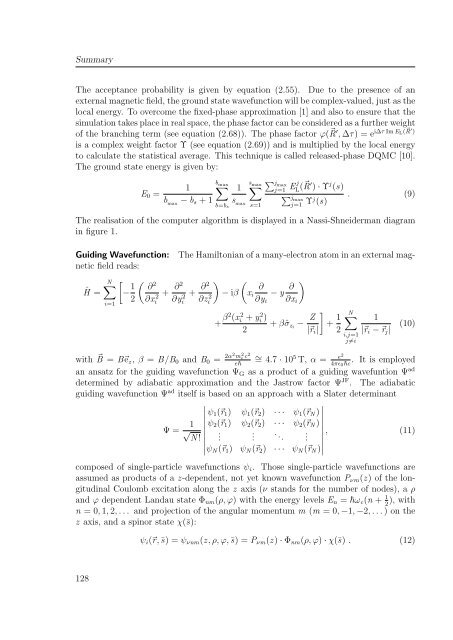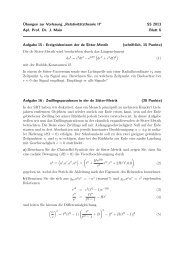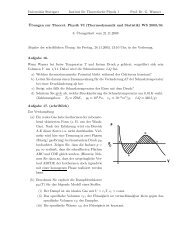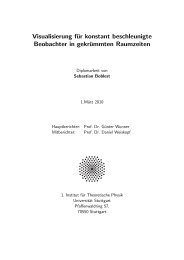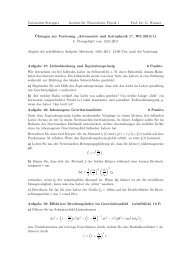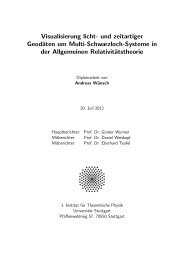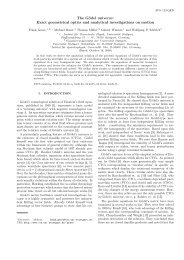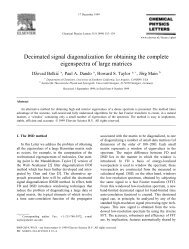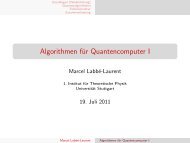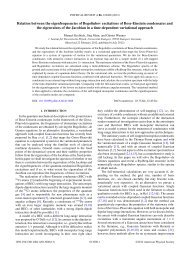2.6M - 1. Institut für Theoretische Physik - Universität Stuttgart
2.6M - 1. Institut für Theoretische Physik - Universität Stuttgart
2.6M - 1. Institut für Theoretische Physik - Universität Stuttgart
Erfolgreiche ePaper selbst erstellen
Machen Sie aus Ihren PDF Publikationen ein blätterbares Flipbook mit unserer einzigartigen Google optimierten e-Paper Software.
Summary<br />
The acceptance probability is given by equation (2.55). Due to the presence of an<br />
external magnetic field, the ground state wavefunction will be complex-valued, just as the<br />
local energy. To overcome the fixed-phase approximation [1] and also to ensure that the<br />
simulation takes place in real space, the phase factor can be considered as a further weight<br />
of the branching term (see equation (2.68)). The phase factor ϕ( � R ′ , ∆τ) = e i∆τ Im EL(�R ′ )<br />
is a complex weight factor Υ (see equation (2.69)) and is multiplied by the local energy<br />
to calculate the statistical average. This technique is called released-phase DQMC [10].<br />
The ground state energy is given by:<br />
E0 =<br />
b<br />
1 �max<br />
bmax − bs + 1<br />
b=bs<br />
1<br />
s max<br />
s� max<br />
s=1<br />
� jmax<br />
j<br />
j =1 EL (� R ′ ) · Υj (s)<br />
�jmax j =1 Υj (s)<br />
. (9)<br />
The realisation of the computer algorithm is displayed in a Nassi-Shneiderman diagram<br />
in figure <strong>1.</strong><br />
Guiding Wavefunction: The Hamiltonian of a many-electron atom in an external magnetic<br />
field reads:<br />
ˆH =<br />
N�<br />
i=1<br />
�<br />
− 1<br />
� 2 ∂<br />
2 ∂x 2 +<br />
i<br />
∂2<br />
∂y 2 i<br />
+ ∂2<br />
∂z 2<br />
� �<br />
− iβ<br />
i<br />
with � B = B�ez, β = B/B0 and B0 = 2α2 m 2 e c 2<br />
xi<br />
∂<br />
∂yi<br />
− y ∂<br />
�<br />
∂xi<br />
+ β2 (x 2<br />
i + y 2 i )<br />
+ βˆσzi −<br />
2<br />
Z<br />
|�ri|<br />
�<br />
+ 1<br />
2<br />
N�<br />
i,j =1<br />
j �=i<br />
e� ∼ = 4.7 · 10 5 T, α = e2<br />
4πɛ0�c<br />
1<br />
|�ri − �rj |<br />
(10)<br />
. It is employed<br />
an ansatz for the guiding wavefunction ΨG as a product of a guiding wavefuntion Ψ ad<br />
determined by adiabatic approximation and the Jastrow factor Ψ JF . The adiabatic<br />
guiding wavefunction Ψad itself is based on an approach with a Slater determinant<br />
Ψ = 1<br />
�<br />
�<br />
� ψ1(�r1)<br />
�<br />
� ψ2(�r1)<br />
√ �<br />
N ! �<br />
�<br />
.<br />
�ψN<br />
(�r1)<br />
ψ1(�r2)<br />
ψ2(�r2)<br />
.<br />
ψN (�r2)<br />
· · ·<br />
· · ·<br />
. ..<br />
· · ·<br />
�<br />
ψ1(�rN ) �<br />
�<br />
ψ2(�rN ) �<br />
�<br />
� ,<br />
. �<br />
�<br />
ψN (�rN ) �<br />
(11)<br />
composed of single-particle wavefunctions ψi. Those single-particle wavefunctions are<br />
assumed as products of a z-dependent, not yet known wavefunction Pνm(z) of the longitudinal<br />
Coulomb excitation along the z axis (ν stands for the number of nodes), a ρ<br />
and ϕ dependent Landau state Φnm(ρ, ϕ) with the energy levels En = �ωc(n + 1),<br />
with<br />
2<br />
n = 0, 1, 2, . . . and projection of the angular momentum m (m = 0, −1, −2, . . . ) on the<br />
z axis, and a spinor state χ(¯s):<br />
128<br />
ψi(�r, ¯s) = ψνnm(z, ρ, ϕ, ¯s) = Pνm(z) · Φnm(ρ, ϕ) · χ(¯s) . (12)


